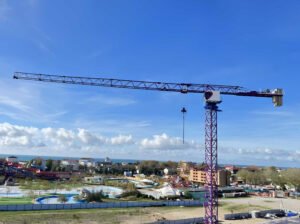Tower cranes are a must-have for any large-scale construction project. You’ve seen them in cities and industrial areas. But have you ever thought about what makes these machines so powerful and efficient? As the CEO of Vega Heavy Industry Co., Ltd., a company that specializes in manufacturing aerial work platforms and lifting equipment, I’ve learned firsthand the importance of understanding every component of a tower crane. Each part plays a crucial role in ensuring safety, efficiency, and precision on the job site.
The main components of a tower crane include the base, mast, slewing unit, jib, counter jib, operator’s cab, trolley, hook block, and counterweights. Together, they form a complex system designed to move heavy loads with accuracy.
Let’s take a closer look at these parts and why they are so vital to the success of your construction project.
Breaking Down the Components of a Tower Crane
1. The Base: Where Stability Begins
The base of a tower crane is the foundation of its stability. Typically, the base is anchored to a concrete pad, ensuring that the crane remains secure even when lifting heavy loads. At Vega Heavy, we focus on precision engineering for our bases to provide a stable platform that distributes weight evenly. This stability is key because any weakness in the base can compromise the crane’s overall performance, leading to costly delays or even accidents on site.
2. The Mast: Providing Height and Support
The mast, or tower, gives the crane its height and supports the other critical components like the jib and operator’s cab. Made from high-strength steel lattice sections, the mast can be extended or shortened depending on the specific requirements of a project. This modular design allows flexibility and ease of transport. Our masts are built with durability in mind, ensuring they can withstand extreme weather conditions and heavy operational loads without compromising structural integrity.
Image Placeholder: Illustration showing the assembly of a tower crane mast section.
3. The Slewing Unit: Powering Movement
Located at the top of the mast, the slewing unit allows the crane to rotate horizontally. This part is crucial for moving loads from one part of the site to another with precision. Our slewing units at Vega Heavy are equipped with high-torque motors that provide smooth, controlled movement even when handling maximum loads. Precision in movement means greater efficiency and safety, which is especially important in high-traffic construction areas where accuracy is critical.
4. The Jib: Extending the Crane’s Reach
The jib is the long horizontal arm that extends from the crane and is responsible for carrying the load. The jib’s design and length directly influence how far the crane can reach across the worksite. A trolley moves along the jib, transporting the hook block that lifts and lowers materials. At Vega Heavy, we design our jibs to be strong but lightweight, optimizing load capacity without sacrificing performance. This balance is crucial for maintaining operational efficiency and avoiding overloading the crane.
5. The Counter Jib: Balancing the Crane
Opposite the jib is the counter jib, which holds the counterweights that balance the load on the working arm. Without the counter jib, the crane would become unstable during operation. At Vega Heavy, our counter jibs are engineered to precisely counterbalance the jib’s load, ensuring safe and efficient operation. Proper balance is not just a safety measure—it also extends the lifespan of the crane by reducing wear on critical components.
Essential Components for Control and Precision
6. Counterweights: Ensuring Stability During Lifts
Counterweights are mounted on the counter jib to balance the crane when lifting heavy loads. These weights are critical for maintaining the crane’s stability and preventing it from tipping over. At Vega Heavy, we use high-quality concrete or steel counterweights that are carefully calibrated to match the crane’s load capacity. This level of precision ensures that the crane operates safely, even when handling the heaviest materials, providing peace of mind on busy construction sites.
7. Operator’s Cab: The Control Center of the Crane
The operator’s cab is where the crane’s movements are controlled. Located on the mast or sometimes on the counter jib, the cab is designed to give the operator full visibility of the construction site. We prioritize ergonomic design and advanced control systems in our cabs at Vega Heavy, ensuring operators have all the tools they need to work efficiently. A well-designed cab allows the operator to focus on precision and safety, making every lift smoother and reducing the likelihood of errors.
Image Placeholder: Interior view of a tower crane operator’s cab with ergonomic controls.
8. The Trolley and Hook Block: Precision in Load Handling
The trolley is a mechanism that moves along the jib, carrying the hook block, which handles the vertical lifting and lowering of loads. The combination of the trolley and hook block allows for both horizontal and vertical movement of materials, giving the crane its flexibility. At Vega Heavy, we focus on optimizing the trolley’s movement to ensure smooth, controlled handling of materials. Our hook blocks are designed to handle heavy loads while minimizing wear on the crane’s pulleys and cables, which improves the lifespan of the equipment.
Conclusion
A tower crane is an engineering marvel, made up of various components that work together to lift and move heavy materials with precision. Each part—the base, mast, slewing unit, jib, counter jib, operator’s cab, trolley, hook block, and counterweights—plays a critical role in ensuring that the crane operates safely and efficiently. At Vega Heavy, we take pride in manufacturing cranes that are not only reliable but also optimized for performance and longevity.
By understanding how each part functions, you can better appreciate the importance of investing in high-quality cranes. The details matter, and when it comes to safety, efficiency, and productivity, each component contributes to the overall success of your project.





